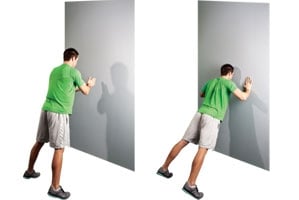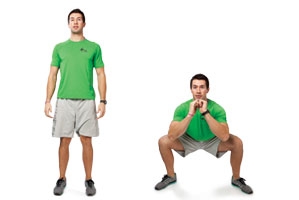
Designed for high-performance athletes, plyometrics can help you kick up your workout to the next level. But a background in strength training is recommended.
Was your response to the title of this article, “Because I have no idea what plyometrics are?” Well, don’t feel too badly—you’re not alone. But this type of training, designed for athletes, may just be the key to elevating your fitness to the next level. Plyometric training is a type of muscular exercise that aims to produce fast, powerful movements over a short period of time. It is designed to train type 2 (“fast-twitch”) muscle fibres by stretching the muscles and then contracting them and is a training staple of professional athletes such as basketball players, gymnasts, and American footballers. In a study done by researchers at the University of Texas-Arlington and Western Michigan University on the effects of plyometric training on agility, the plyometric training group had significantly quicker post-test times than the control group. Other benefits of plyometrics include improved bone health, increased muscle strength and coordination, and the development of type 2 muscle fibres. Tips for beginners According to an article published in the Health and Fitness Journal of Canada, “Plyometrics are not for the beginner exerciser.” Rather, a background in strength training is strongly recommended for anyone adopting a plyometrics program. Further, plyometric exercises should be done in progression, and only body weight should be employed for the general population. Because plyometrics are so dynamic and explosive in nature, it is paramount that the exerciser command precise form. Additionally, proper breathing to brace the core is crucial—always exhale on exertion and inhale on release. While the rewards of adding plyos to your routine can be great, the potential risks deserve equal attention. Muscle strains and repetitive joint impact stress on knees, wrists, elbows, shoulders, and hips are all possible. The risk of injury can be decreased by a proper dynamic warm-up, a proper cool-down and stretch, and constant attention to detail. Additionally, the muscles used during plyometric training should be rested for at least 24 hours before being worked again. To start, try implementing plyos once per week. If you have a strong foundation in strength training and are looking to shake up your current routine and realize the athlete within, use the following exercises to add some power to your program!
Burpee (6 to 8 reps)

Begin in a standing position with feet shoulder-width apart. Bend your knees and place your hands on the ground in front of your feet so they are also shoulder-width apart. Jump your feet behind you so your legs straighten out and you land in a push-up position. Be mindful of your hips staying in line with your shoulders so your lower back does not sag. Immediately hop your feet back in—as close to your hands as possible—and stand up, keeping your weight on your heels and your back flat. It is important to minimize the amount of time your toes spend on the ground while in the push-up position, so once you achieve a perfect push-up pose, quickly bend your knees and hop back in. Variation When you put your hands on the ground to initiate the burpee, step your legs back one at a time as fast as possible, and then step them forward one at a time once the push-up position is achieved. Wall clap push-up (6 to 8 reps)

Begin standing on your toes with feet shoulder-width apart and hands slightly wider than shoulder-width apart and at shoulder height on a wall in front of you. Quickly let your upper body fall forward toward the wall with bent elbows, being mindful not to let your hips fall forward. Push yourself away from the wall as fast as possible, clapping your hands together after your arms become fully extended. Immediately extend your hands in front of you in the same position you started, absorbing your body weight and minimizing the time spent on the wall. Progression Begin in a kneeling push-up position with hands just wider than shoulder-width apart. Quickly sink toward the ground and then push up as fast as possible, clapping your hands together at the peak of the push-up. Repeat this motion without pausing. Lunge changes (6 to 8 reps)

Begin in a lunge with your weight on the heel of the foot in front of your body and the other foot extended as far behind you as possible while keeping the ball of the foot on the ground. As fast as you can, jump up and switch foot positions, landing both feet at the same time with your weight on your front heel. To ensure balance throughout the exercise, allow your arms to relax and counter the leg that goes forward (if left leg is forward, right arm goes forward). Variation From the same starting position, jump straight up in the air and come down in the same position instead of switching feet. Repeat this motion without pausing. Medicine ball side toss (6 to 8 reps per side)

On one knee and with a wall beside you, extend the leg farthest from the wall in front of you with a bent knee (like a lunge with your back knee on the ground). Hold the medicine ball in your hands with elbows bent above your front knee. Twist away from the wall as far as possible and then suddenly twist toward the wall and release the medicine ball. You should be close enough for the ball to hit the wall and bounce right back into your hands. Repeat with no pauses. Variation There’s no need for a wall with this variation. Sit on the ground, leaning slightly back with your legs together in a slightly bent position. Keeping your elbows at your side, touch the ball to the ground beside you and quickly bring it back to the middle. After a brief pause, do the same on the other side of your body. Fitness model Brendan Rolfe is a personal trainer and nutrition specialist at RAWE Health Solutions. rawehealth.com Broad jump bounding (6 to 8 reps)

From a standing position, quickly drop into a squat with your weight on your heels, your knees over your toes, and a flat back. Leap forward as far as you can, throwing your arms forward to initiate the movement. Land on your feet in a bent-knee position with the weight on your heels, and as soon as you touch the ground, leap forward again in the same manner. Variation Decrease your jump distance, focusing exertion through the calf muscles instead of the upper legs. V-ups (8 to 10 reps)

Lie flat on your back with your legs straight and your arms straight behind your head. Draw your belly button toward your spine and quickly raise your arms and legs (keeping them straight) so they touch above your body. Be sure to lift your shoulders and bum off the ground at the same time to achieve optimal results. Variation Lying down, rest your elbows on the ground behind you, raising your upper body off the ground. Keeping your weight on your elbows, quickly bend your knees and tuck them into your chest. Straighten them out in front of you once again and repeat. Drop squats (8 to 10 reps)

Standing with your arms to your sides and your feet together, jump your feet out wider than shoulder-width apart with toes pointed outward at a 45-degree angle. While keeping your back flat, your knees over your toes, and your weight on your heels, drop into as low a squat as you can, letting your arms swing out in front of you for counterbalance. As soon as you drop, immediately pop back up to starting position and drop again without pausing. Variation Perform the same motion, but instead of starting with your feet together, start with them already shoulder-width apart with toes pointed outward at a 45-degree angle. Do the drop squats without moving your feet.
TIP: food for fuel Power is nothing without the right fuel. Consult your local health food store to see which foods can add pep to your step.





